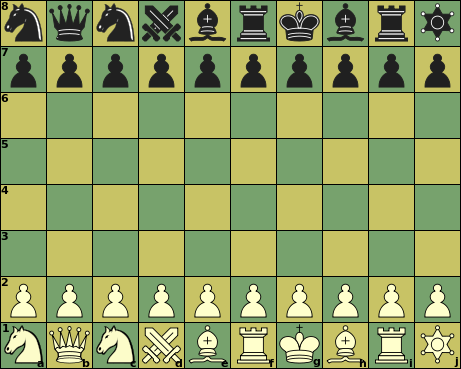Capablanca Random Chess (CRC)
 |
Initial setupThere is no fixed setup; the back-rank pieces are randomly shuffled with certain restrictions. Black's setup is the mirror image of white's, though. Both sides have: 1 King The Bishops must start on different colors. The King must start between the Rooks. It has been suggested the Bishops should also not start next to each other. |
Moves at a Glance
Click on a piece below to see its moves
 |
 |
 |
 |
Sliding capture or non-capture, can be blocked on any square along the ray |
|||||||
 |
Unblockable leap (capture or non-capture) | ||||||||||
 |
 |
Non-capture only | |||||||||
 |
Capture only | ||||||||||
 |
|||||||||||
 |
 |
 |
 |
 |
 |
 |
|||||
 |
|||||||||||
:
:
:
:
| Piece | ID | value | Moves (Betza notation) | Remarks |
| King | K | - | K | Can castle with Rook, moving 3 steps towards it |
| Queen | Q | 9.5 | RB or Q | |
| Chancellor | C | 9 | RN | |
| ArchBishop | A | 8.75 | BN | |
| Rook | R | 5 | R | |
| Bishop | B | 3.5 | B | Color-bound |
| Knight | N | 3 | N | |
| Pawn | P | 1 | mfWcfF | Promotes to Q, R, B, or N on reaching last rank |
Pawn peculiarities
- Pawns capture differently from how they move (straight move, diagonal capture).
- Pawns can move two squares ahead from their initial position, provided they are not blocked.
- On the move immediately after such a double push, they can be captured en passant by another Pawn, as if they had only moved 1 square ahead.
- Pawns promote to another (non-royal) piece of choice when they reach last rank.
Castling
A King that has not moved before can move to the c1/c8 or i1/i8 in the direction of a Rook that has not moved before, in which case that Rook is moved to the square on the other side next to the King. This is only allowed if all squares traveled through by King and Rook are empty (after their removal), when the King is not in check on the square it came from, and would not be in check on any of the squares it skipped over.
General rules
- It is not allowed to expose your King to check.
- The game is won by checkmating the opponent's King.
- Stalemate (no legal moves, but not in check) is a draw.
You can use the New Shuffle dialog to control the randomization of the initial position.
Differences with FIDE
The Chancellor and Archbishop pieces are extra, and the board is expanded to accomodate them. Castling is generalized to allow it with non-standard placement of King and Rooks.
Strategy issues
It is not possible to force checkmate on a bare King with just a single Bishop or Knight (in addition to your own King). Two Knights cannot do that either. The Archbishop can force checkmate against a bare King.
Bishops are confined to squares of a single color. Having Bishops on both colors compensates this weakness, and is worth an extra 0.5 on top of their added value.
As Chancellor and Queen are nearly equal in value to Queen, under-promotion is very common, and there is virtually never any need to promote to R, B or N.
The super-pieces (Q, C, A) devaluate by the presence of lower-valued opponent pieces. As a result trading Q for R + B is in general a good trade when you still have both J, as the latter gain in value by eliminating the opponent's R and B, which is more compensation than the intrinsic value differene between Q and R + B.